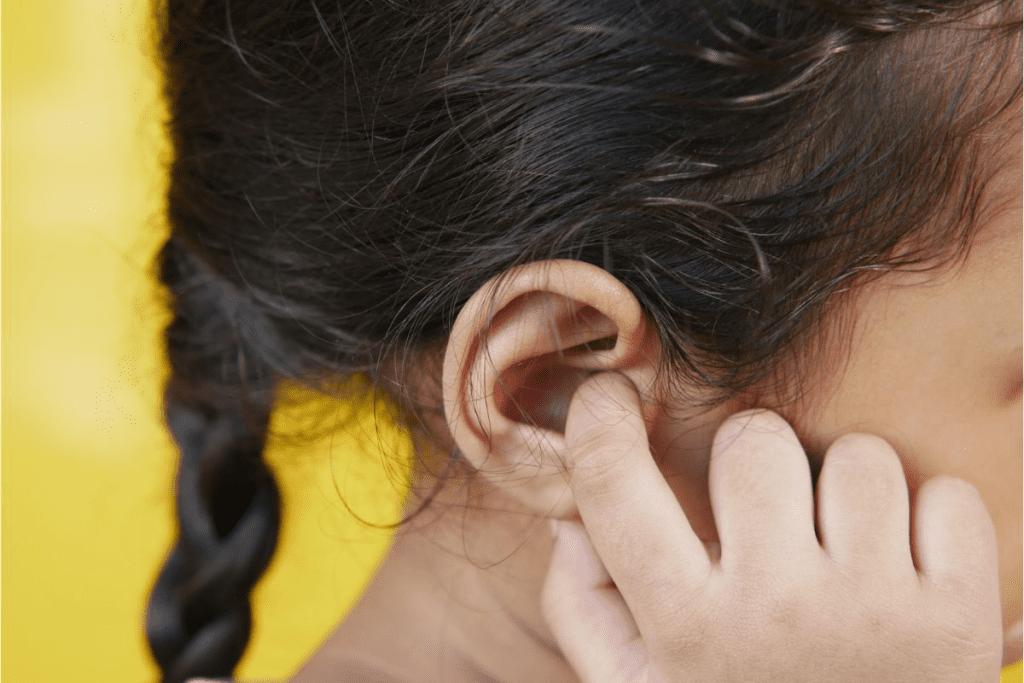Last Updated on November 14, 2025 by
Ear infections are a common issue in pediatric care, affecting a significant percentage of young children. About 50“85% of children between 6 months and 3 years experience at least one ear infection.

Distinguishing between viral and bacterial ear infections can be challenging. This is because the symptoms of what do ear infection look like often overlap. Understanding the differences is key to effective treatment.
Recognizing the signs of ear infection in babies is vital for parents. Symptoms like irritability and fever are important to watch for. Knowing if the infection is viral or bacterial helps guide treatment and brings peace of mind.
Ear infections in kids are a big worry for parents, often leading to doctor visits. These infections, also called otitis media, can be very painful. Knowing about ear infections helps parents spot symptoms early and get the right help.
About 50“85% of kids between 6 months and 3 years get at least one ear infection. Young children, under 3, get them the most. This is because their immune systems are not fully grown, and their Eustachian tubes are different from those of adults. Ear infections are the top reason parents take their kids to the doctor.
Several types of ear infections can affect children. The most common include:
Knowing these types helps parents spot ear infection signs in their kids. It also helps them get the right medical care.
Knowing if your ear infection is viral or bacterial is important for treatment. Most ear infections are viral. But some can be bacterial or a mix of both.
Viral ear infections come from the same viruses that cause colds or flu. They often happen as a side effect of a viral cold or flu. Bacterial ear infections, by contrast, are caused by bacteria like Streptococcus pneumoniae or Haemophilus influenzae.
Bacterial infections usually have more severe symptoms. These include a high fever, intense ear pain, and sometimes pus or discharge. Viral ear infections, on the other hand, have milder symptoms. These can often be treated with over-the-counter pain relievers.

The length and how an ear infection progresses can differ a lot. Viral ear infections usually get better on their own in a few days to a week. Bacterial ear infections, though, might need antibiotics to heal. If not treated, they can lead to serious problems.
Both viral and bacterial ear infections can spread, but it’s more about the cause than the infection itself. For example, if the ear infection comes from a cold or flu, the virus causing it can spread.
Knowing how contagious an infection is can help stop it from spreading. Good hygiene, like washing your hands often, can help prevent it.
Ear infections in kids can show different signs. Knowing these signs helps tell if it’s a viral or bacterial infection. It’s vital for parents to spot these symptoms early to get their child the right care.
Both viral and bacterial ear infections share similar symptoms. This makes it hard to tell the type without a doctor’s check-up. Common signs include:
Doctors say ear pain is a common symptom, but it’s hard to know if a child is feeling it. Learning about ear infections helps parents know when to seek help.
Bacterial ear infections often have more severe symptoms. These include:
A child with ear pain and no fever might have an ear infection. But, no fever could mean it’s viral or a mild bacterial infection.
Viral ear infections usually have milder symptoms. These include:
It’s hard to tell if a baby’s ear infection is present, as babies can’t say they’re in pain. Watch for signs of irritability or changes in behavior.
Experts say cold symptoms with ear pain might mean it’s viral. This shows the need to look at the whole picture when diagnosing ear infections.
Diagnosing ear infections involves a physical exam and medical tests. Getting the diagnosis right is key to treating the infection effectively.
A healthcare provider starts by looking at the ear with an otoscope. This tool lets them see the eardrum and ear canal clearly. They look for signs of infection like redness, swelling, or fluid behind the eardrum.
In some cases, a pneumatic otoscope is used. It checks how well the eardrum moves by blowing air gently against it.

More tests might be needed for a detailed check-up. Tympanometry is a common test. It checks how well the eardrum moves and the middle ear muscles’ reflexes. It helps find out if there’s fluid in the middle ear or if the Eustachian tube works properly.
Parents should know when their child needs to see a doctor right away. Signs that mean urgent care is needed include:
If your child shows any of these signs, get them to a doctor fast. This helps avoid serious problems and makes sure they get the right treatment.
Knowing if an ear infection is viral or bacterial is key to picking the right treatment. The type of infection greatly affects how it’s managed.
Viral ear infections usually get better on their own without antibiotics. The main goal is to ease symptoms and let the body heal naturally. Pain relief is important, and can be helped with medicines like acetaminophen or ibuprofen.
Parents should keep a close eye on their child’s symptoms. Making sure the child rests and stays hydrated can help with pain and recovery.
Bacterial ear infections might need antibiotic treatment to kill the bacteria. Doctors consider the child’s age, how bad the symptoms are, and their overall health before deciding on antibiotics.
In some cases, doctors might wait a bit to see if the infection gets better on its own. This helps avoid overusing antibiotics and prevents antibiotic resistance.
Helping children feel better is a big part of treating ear infections. Doctors often suggest over-the-counter pain medicines like acetaminophen or ibuprofen. Applying a warm compress to the ear can also help.
Creating a cozy environment for the child is also important. This includes keeping their head up while sleeping and using distractions to manage pain.
Parents should work closely with their doctor to find the best treatment for their child.
Keeping children’s ears healthy is key to their well-being. By taking steps to prevent ear infections, we can greatly reduce their risk.
Vaccines like the flu shot and pneumococcal conjugate vaccine (PCV13) help a lot. Breastfeeding is also good for babies’ ears. And, staying away from cigarette smoke is very important.
For kids with frequent ear infections, ongoing care is needed. Regular doctor visits help keep an eye on their ears and fix any problems fast.
Knowing what causes ear infections and how to stop them helps parents. By preventing and managing ear infections, we can make our children’s lives better.
Signs include ear pain, fever, and irritability. Changes in behaviour or sleep patterns are also common. Infants might tug or pull at their ears.
It’s hard to tell without a doctor’s check-up. But bacterial infections usually cause more severe symptoms like high fever and intense ear pain.
AOM is an infection with inflammation and fluid in the middle ear. It often comes with ear pain and fever. OME is when fluid stays in the middle ear after an infection, possibly causing hearing issues.
Doctors use otoscopy to look at the eardrum and sometimes tympanometry to check the middle ear. They also consider the child’s symptoms and medical history.
Yes, some viral and mild bacterial infections might get better with supportive care like pain relief. But antibiotics are often needed for bacterial infections.
Over-the-counter pain relievers like acetaminophen or ibuprofen can help. A warm compress on the affected ear may also offer relief.
Keep your child’s vaccinations up-to-date. Practice good hygiene, breastfeed, and avoid smoke exposure.
Yes, they can lead to hearing problems, speech delays, or eardrum damage. Regular check-ups and proper management are key to preventing these issues.
Get immediate help for severe symptoms like high fever, intense ear pain, or discharge. Also, seek help if your child shows signs of hearing loss or other concerning symptoms.
Yes, avoiding smoke, practicing good hygiene, and keeping vaccinations up-to-date can help lower the risk of ear infections
Subscribe to our e-newsletter to stay informed about the latest innovations in the world of health and exclusive offers!